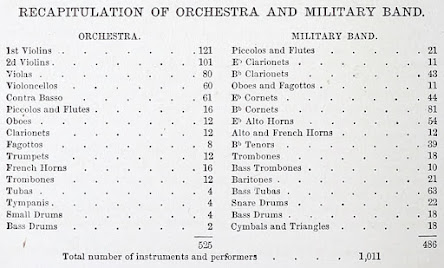My family visited Boston for the first time this summer, and that encouraged me to poke around to see what I could learn about the National Peace Jubilee, held in Boston on June 15-19, 1869. This massive event was conceived and led by the great bandmaster P. S. Gilmore, who, two years later, wrote a massive history of it (758 pages!). Here's the cover page (the entire book is available online courtesy of the HathiTrust):
I am familiar with every step of [the Jubilee's] progress, from its inception to its consummation; but can I write it out so as to make it interesting to the general reader? that is the question. Well, I can try! The result of the trial - and a very severe trial it has been! - is this volume, which the author gives to the public with great reluctance, feeling it is not in many respects what is expected, nor what it ought to be. Still he hopes its shortcomings may be overlooked, it being his first, and in all probability his last, effort in the field of literature.He then concluded the introduction by saying, "critics and reviewers are respectfully requested not to put too fine a point upon their pencils, remembering that 'Blessed are the merciful, for they shall obtain mercy' [a quote from the Bible - Matthew 5:7]."
I like this guy already - and I'm eager to dive into the book (but, okay, maybe not all 758 pages!).
As you perhaps picked up from the title page, this musical event was "to commemorate the restoration of peace throughout the land," referring to the end of the Civil War four years earlier. But what was of greatest interest to me, for starters, was the magnitude of the musical forces Gilmore assembled.
At the end of the book are long lists of all of the musicians involved, which included 10,404 singers, making up the enormous Chorus, and 1,011 instrumentalists, between the Grand Orchestra and the Military Band. The steel engraving at the top of this post, which is included in the book, shows those combined forces in concert.
Here is the breakdown of the instrumentalists:
So, make note: 4 tubas in the Orchestra, and 63 in the Military Band, which totals 67! Here are the names of the 63 bass players in the Band:
Fun side note: I stumbled upon a couple of cartoons, featured in Harper's Weekly (archives are online), showing playful depictions of the combined musical forces, including some tuba players. Here's the one in the June 19, 1869 edition:
And here's the close-up of some of the tubas in this wacky illustration:
And here's the cartoon in the July 3, 1869 edition which shows the exhausted musicians leaving the Jubilee.
In the bottom right corner, you can even see one tuba player being carried out on a stretcher! Here's the close-up of that:
Anyway, here's where they performed - in the special Coliseum built for the event at St. James Park (where Copley Square is today), which was designed to seat around 50,000 (again, these steel engravings are included in Gilmore's book):
Pieces that were performed over the five day festival included selections from Haydn's "Creation," Handel's "Messiah," Mendelssohn's "Elijah," as well as "St. Paul," Beethoven's 5th Symphony, overtures by Wagner and Rossini, and more. But the musical highlight was likely the following, which was performed both on the first day and the third day, as scheduled, but also included on the second day, by popular demand:
In this rousing performance, every musician was involved - including all 67 tuba players - but, as you can see in the description, there were also one hundred anvils struck by one hundred members of the Boston Fire Department, along with the chiming of all the bells of the city, and cannons blasting at the appropriate times.
If ever there were a moment where "you had to be there," this was it! Can you imagine what that sounded like? Here's the report from the next morning's edition of the Chicago Evening Post:
The New York Times was less enthusiastic about the opening day concert, noting the challenges of working with such a huge group of musicians, and they referred to the "Anvil Chorus" as "clap-trap," but then confessed that "It's performance was remarkably good":
I look forward to digging into this book more, but for now, I just want to marvel at the vision and determination of P. S. Gilmore in pulling off one of the greatest musical festivals our country has ever experienced. And yet, almost no one knows about it. I hope this post will help change that.
Here's what Gilmore included on the last page of the book, which reveals both his devotion to God and his patriotism for his adopted country (he was an Irish immigrant):
Click here for the 1969 article published in American Heritage magazine in celebration of the 100th anniversary of the National Peace Jubilee. It's a fun read!















No comments:
Post a Comment